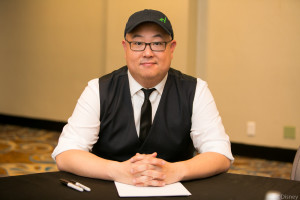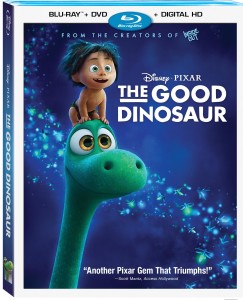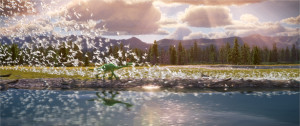The Good Dinosaur arrives on DVD and Blu-Ray today and The Movie Mensch got a chance to sit down with the director of the film, Peter Sohn, for a chat recently at the Sofitel Hotel in Beverly Hills.
The latest from Pixar-Disney has been six years in the making and has gone through a couple of incarnations. The version that landed on the big screen this past November and became another in a long line of hits for the fabled animation studio finds a dinosaur named Arlo (voiced by Raymond Ochoa) who gets separated from his family and meets up with a primitive child named Spot. The film chronicles their unlikely friendship, stresses the importance of kin and features some of the most brilliant and beautiful animation we’ve ever seen.
Given all the resonant themes and visual power presented throughout the film, we wanted to know where the inspiration for the Western-set world of The Good Dinosaur came from for the helmer.
“It was early on… just the idea of a dinosaur farmer plowing the earth. And then taking the herbivores into farming land and making carnivores into ranchers,” Sohn reported.
In this world, like the early settlers of the Old West, everyone is trying to live to see another day, all while trying to start a life and leave a familial legacy. “There was this real survival quality to this that was really interesting. Denise [Ream, the film’s producer] sent us out on research trips and we met this one ranching family, the McKay’s, and they were this beautiful family and they were living this beautiful life up in Oregon herding cattle.”
Sohn found himself feeling a little bit like Billy Crystal in that iconic film from the early 90s.
“When we went up there, it was pretty much like City Slickers. I’m from New York. I’d never done anything like that before. This family was so pure and it made me think of my family. I grew up in New York in a grocery store and we would all work together to survive in the city and make a life for our family,” Sohn said.
“This was the same thing. The McKay family was surviving, but out in this incredible country. So there was this connection for me — there was this universal idea here.”
The feel and emotional pull of the film was firmly in place, now Sohn and his team focused on the texture, the landscape and the visual majesty that is the trademark of the U.S. western topography.
“It’s incredible,” Sohn said of The Good Dinosaur’s animation. The team at Pixar achieved something truly organic and exquisite. “Hopefully, we captured something that we saw. It’s not like we were trying to create a whole new place. We were trying to capture the emotion of a place. Where it’s just like, ‘Boy, look how soul-enriching these landscapes are? It’s dwarfing me and making me feel things that I didn’t feel,’” Sohn said.
As large as the mountains and sprawling valleys can feel, there are more intimate moments of being in the outdoors in the American west that Sohn wanted embedded in his The Good Dinosaur world. “There are moments that are so small, like looking at a leaf and seeing how raindrops slide down the leaf,” he said. One thing animators had to keep in mind the whole time they were creating this majestic world, audiences needed to see this world through Arlo’s eyes.
“[We] all had to stick to an eleven-year-old’s point of view of the world where he’s terrified but then there are these little bits of beauty that we saw out there and trying to respect that.”
The director could not be prouder of the team at Pixar that produced The Good Dinosaur. He was supposed to be the lead inspirer, but on many days, it seemed like it was the animators that were feeding his imagination.
It was a completely collaborative effort. All I did was want to learn animation so I went to school for it. Working with animators in this capacity was some of the most amazing things that I’ve ever seen,” Sohn said.
He illustrates the Pixar magic with how they created one of the more emotional moments in the entire film. “We talk about this moment in the film, when Arlo is explaining to Spot that he misses his family, and Spot is an animal at this point, and Arlo thinks, “Oh, you don’t get it.” But then Spot breaks that communication barrier by doing these dog-like things like putting the stick down. But then Arlo realizes that Spot is communicating with him. And after Spot places the sticks, he gets into this dog-like position. Then — when he buries his family — he sits up like a kid. And he does this little movement (the director wipes his nose). Which is a very subtle, human gesture,” Sohn said.
“Talking to this group, the animator would say, ‘I added this little thing there.’ We are all like, ‘Holy cow, that’s amazing.’ It was just this collaborative thing and everyone putting themselves into it.”




